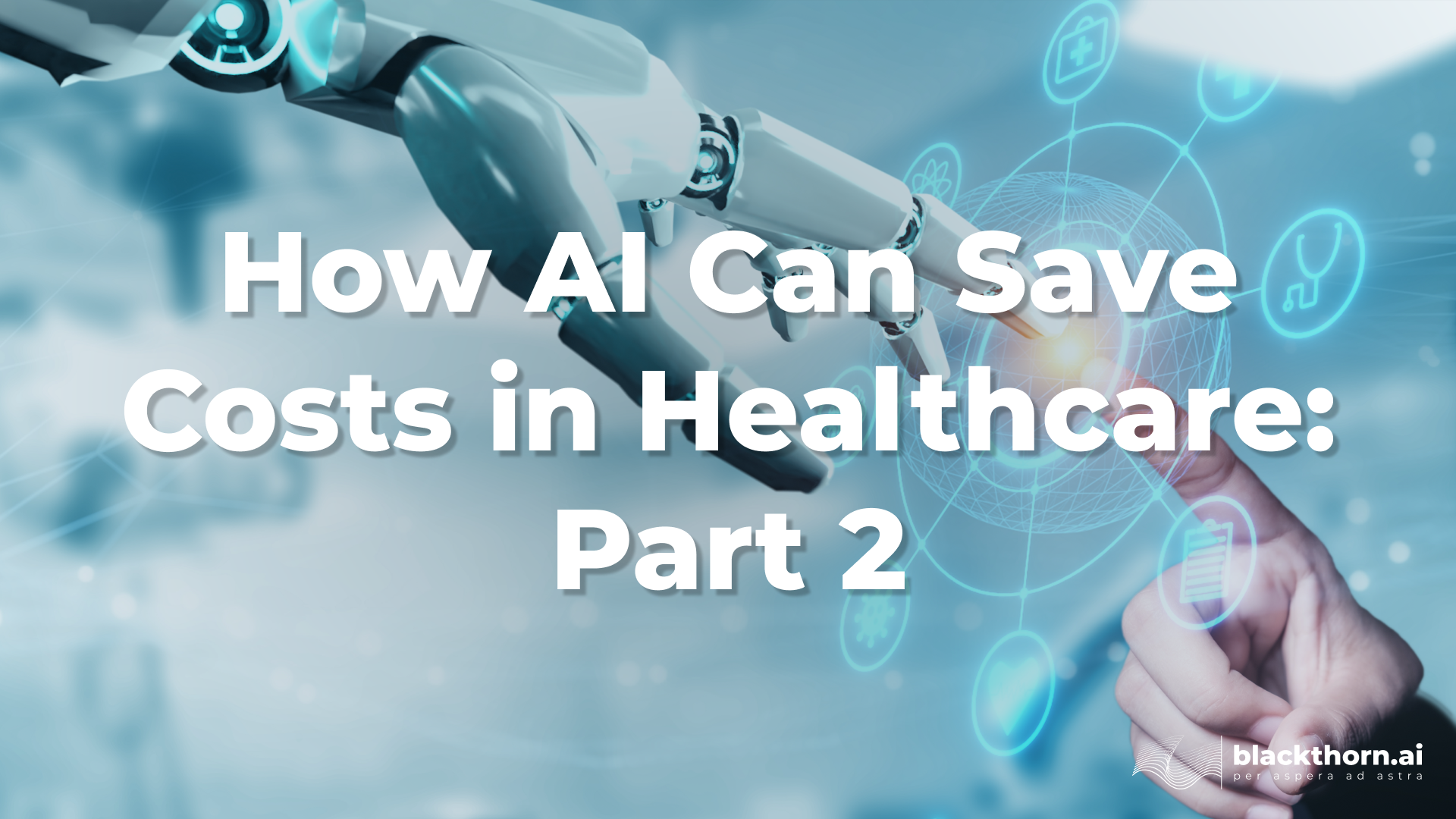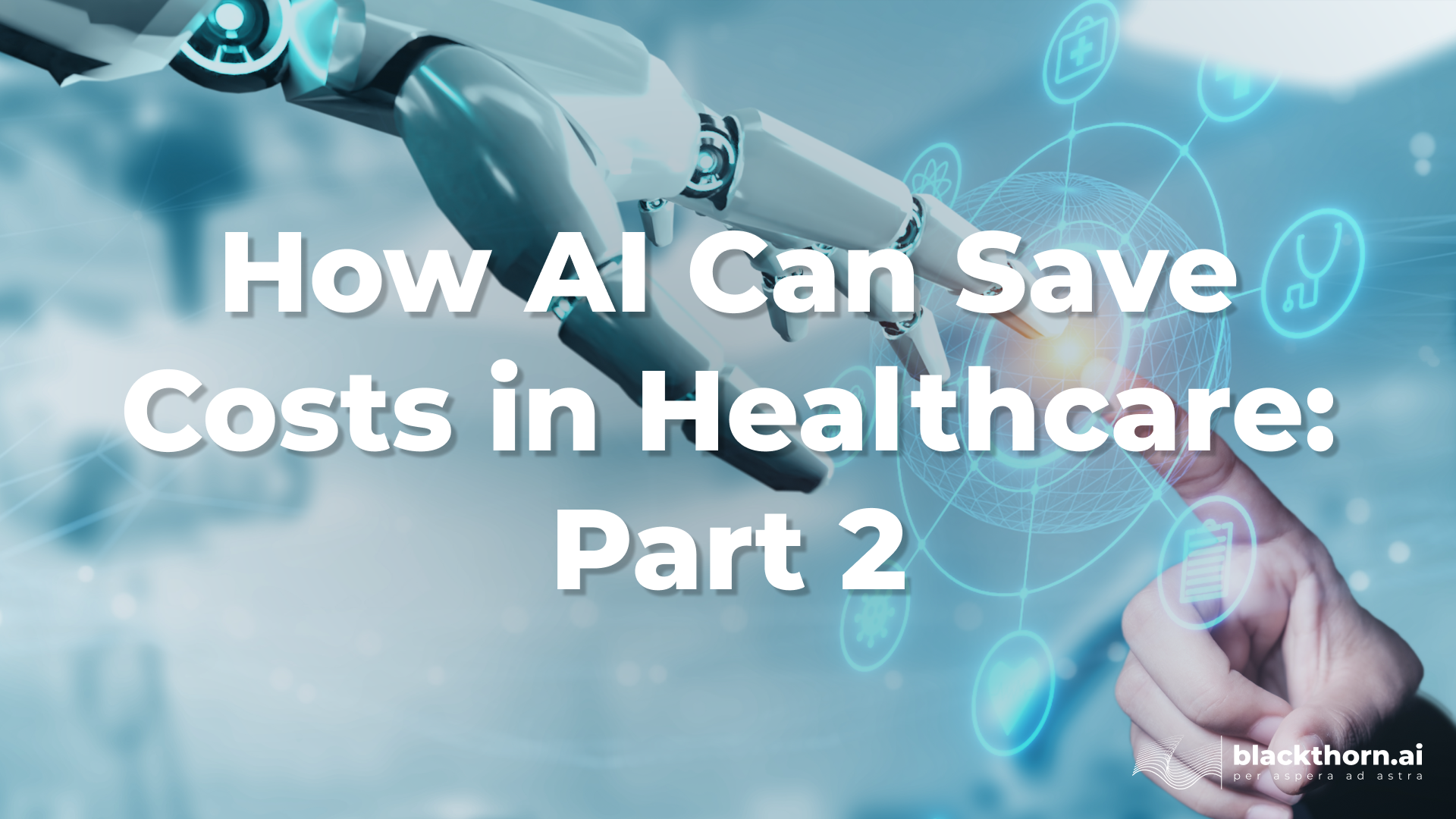
AI and AI-based automation could cut US healthcare spending by $200 billion to $360 billion annually, which alone seems impactful. In addition, the automation could help healthcare providers increase efficiency and quality of services. Client-oriented solutions could also improve accessibility, patient experience, and satisfaction. However, these solutions have to be integrated and created first. This post brings the factors that have to be taken into account before determining an exact price.
This is the second post of a three-part blog. In the first one, we discussed the ways of saving costs with Artificial Intelligence (AI) implementations.
3. How Much Does Artificial Intelligence Cost in Healthcare?
Implementing AI-powered systems in healthcare can contain various solutions such as medical imaging analysis, clinical decision support, remote monitoring, natural language processing for documentation, human-like client support bots, and drug discovery. Costs can vary widely depending on factors like the complexity of algorithms, integration needs, and customization requirements. Generally, expenses range from tens of thousands to millions of dollars.
As various and complex AI solutions can be, so is their price range. Suppose you want to know how much AI enhancement of your system will cost. In that case, you can contact us here, or do it yourself assessing the factors that are mentioned in this post. Implementing AI in healthcare can involve many factors that change the complexity and cost of development.
Therefore, we can determine two main groups that affect the cost of AI tools: development and non-development factors. The first contains aspects that impact a system’s design, development, integration, and maintenance. These are purely technical aspects of development that mainly depend on solution complexity, data availability, and integration readiness of an existing system.
The second group includes non-development factors that can affect the cost of integration. These factors are more about compliance with regulatory standards, educating the staff to use AI solutions and other aspects of the solution. We will discuss both groups in detail in the following two topics.
Estimating how much AI integration can help save is as complicated as estimating the cost of implementing AI in healthcare due to the myriad of different solutions and even more ways they impact the processes of the existing ecosystem. For example, implementing AI-powered tools to streamline administrative processes and minimize medical errors reduces staffing expenses, paperwork, and reliance on expensive diagnostic tests, directly contributing to increased profitability. Moreover, leveraging AI for personalized treatment planning, early disease detection, and proactive interventions enhances patient outcomes and satisfaction. Such an individual approach may lead to higher patient retention rates, increased referrals, and a more substantial reputation within the community, ultimately driving profitability through enhanced patient loyalty and positive word-of-mouth referrals.
Furthermore, AI-powered solutions help healthcare organizations tap into new revenue streams by facilitating the development of innovative services and products such as telemedicine platforms, remote monitoring devices, and personalized treatment plans. These offerings may provide valuable insights into patient populations and healthcare trends, informing strategic business decisions and driving targeted marketing efforts, and aid in risk mitigation by identifying and addressing potential issues such as hospital-acquired infections and medication errors, safeguarding financial health and profitability through proactive measures.
In summary, implementing AI in healthcare can deliver tangible returns on investment by reducing costs, improving efficiency, enhancing patient outcomes, generating new revenue streams, gaining a competitive advantage, and mitigating risks. By strategically leveraging AI technologies, healthcare organizations can become more profitable by reducing healthcare costs through technology. However, it heavily depends on the type of solution, its implementation, and integration. All those factors make it difficult to name each solution’s price mindlessly.
4. What Factors Affect the Cost of Integrating AI Solutions into Healthcare?
Although the economic impact of AI in healthcare can often be overlooked, the initial investment seldom is. The range of the AI solution price leaves people wondering why such variability exists and what factors contribute to it. The cost of implementing AI in healthcare can be influenced by various factors, including:
- Development and Implementation Costs: The initial investment in developing AI solutions can vary depending on factors such as the complexity of the algorithms, the level of customization required, and the development team’s expertise. Custom-built AI solutions tailored to specific healthcare needs may entail higher development costs than off-the-shelf solutions but are more robust.
- Data Collection and Processing: AI algorithms rely on large volumes of high-quality data to train models and make accurate predictions. Acquiring, cleaning, and managing healthcare data can be costly and time-consuming, especially if data sources are fragmented or conflicting. AI is most effective when applied to digital and automated business processes after integrating and centralizing data sources. Also, healthcare organizations may need to invest in data infrastructure, storage, and security measures.
- Integration with Existing Systems: Integrating AI solutions into existing healthcare IT systems, such as electronic health records (EHR) and hospital information systems (HIS), can involve high costs. Compatibility issues, data migration, and interoperability challenges may require additional resources and expertise to address effectively. It is even more costly if part of the business processes that AI solutions have to be involved in are manual. On the other hand, due to its flexibility, server-oriented or micro-service architecture will ease integration into one or part of the services. Even the accessibility of the existing system can affect the cost depending on whether it is easily accessed as a cloud-based solution with full remote access or an enclosed system on-premises.
- Scalability and Expansion: Healthcare organizations may need to scale up AI implementations to accommodate growing patient volumes, expand into new service areas, or adapt to changing healthcare needs. Scalability considerations, such as cloud infrastructure, licensing fees, and support services, can impact the overall cost of AI integration but will ease scaling up to full automation. It is better to consider such options at the early stages.
Overall, the cost of developing and integrating AI solutions into healthcare is influenced by a combination of development, data management, integration, and scalability factors. Healthcare organizations must carefully assess these factors before the integration and some of them before considering the development, for example, optimizing existing infrastructure and data availability.

5. Non-Development Costs
All technical requirements and factors may feel like all you need to account for. So, how much does artificial intelligence cost? Not so fast. In addition to the development, other factors can impact the price of enhancing the healthcare system with AI. These considerations play a significant role in determining the overall investment in an extended play:
- Staff Training and Education: Healthcare professionals must be trained to use AI tools effectively and interpret the insights generated by these systems. It is necessary to make sure staff see the benefits of AI, don’t fear it, and use it to improve efficiency. Training programs, workshops, and ongoing support services require additional costs for healthcare organizations.
- Regulatory Compliance: Compliance with regulatory standards and certifications, such as FDA approval for medical devices or GDPR compliance for data protection, adds to the cost of developing and deploying AI solutions in healthcare. Ensuring that AI algorithms meet stringent regulatory requirements may involve extensive testing, documentation, and validation processes.
- Vendor Selection: Choosing the right AI vendor or technology partner is critical to the success of AI integration in healthcare. Factors such as reputation, expertise, and support services influence the total cost of ownership and the long-term viability of AI solutions.
- Data Storage and Management: Acquiring and managing large volumes of healthcare data, including cleaning, organizing, and storing data, can be costly. This management includes expenses related to data collection from various sources, ensuring data quality and integrity, and complying with data privacy regulations.
- Maintenance and Updates: Most AI solutions require regular maintenance, updates, and monitoring to ensure optimal performance and accuracy over time. Maintenance includes monitoring for algorithm drift, updating training data, and incorporating user feedback. Maintenance costs can vary depending on the complexity of the AI system and the frequency of updates required. Some can be automated, while more complex ones may require humans in the loop to evaluate and support the performance of new iterations of the AI solution.
- Security and Data Privacy: Ensuring the security and privacy of patient data is paramount in healthcare AI implementations. Investing in cyber-security measures, encryption technologies, access controls, and compliance with data protection regulations adds to the cost of AI integration.
By considering these factors alongside development costs, healthcare organizations can better understand the total cost of integrating AI solutions and develop comprehensive strategies to maximize the value and ROI of AI investments. In the next post, we will talk about the appropriateness of an AI solution for a Healthcare provider.

